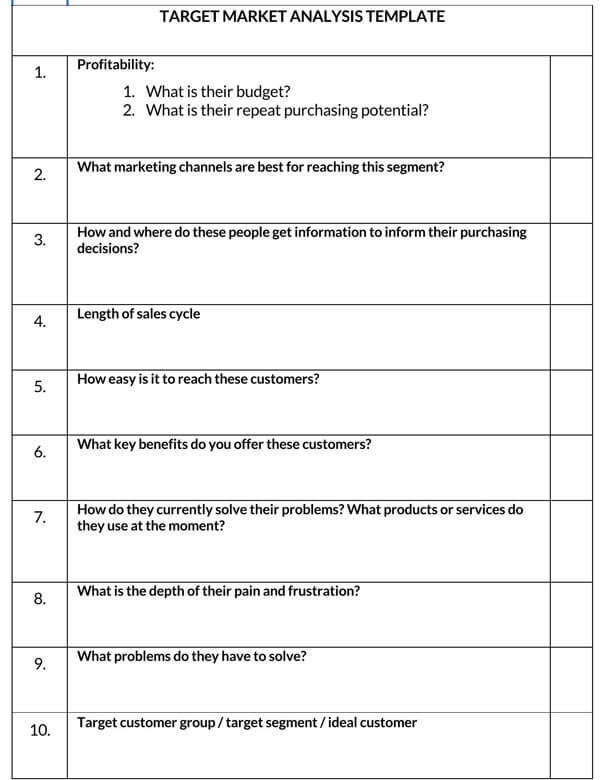Target market analysis is the process of selecting a market segment that satisfies an organization’s marketing objectives and requirements.
It generally involves analyzing consumer preferences for certain product attributes, such as price, quality, and features. It provides a high-level perspective of what consumers are looking for in a product or service and the reasons why they buy a particular brand.
Target market analysis is generally conducted with three major objectives in mind:
- To identify profitable markets that will satisfy organizational objectives
- To help determine whether products/services currently offered by an organization should remain on the market with the current product/service, modified or discontinued,
- To help determine which potential target markets should receive more attention in the future.
It is generally conducted at three different levels:
- Macro-level: One that takes a broad overview of the entire market in which an organization operates;
- Micro-level: A more detailed, company-specific view of the target market;
- Nano level: A detailed, customer-specific outlook that can be easily adapted to the individual needs of each targeted customer.
Target Market Analysis Templates


Benefits of Target Market Analysis
A target market analysis provides a detailed breakdown showing the consumer’s preferences for certain product attributes such as price, quality, and features. Identifying who could potentially be served by a product or service helps an organization understand what the consumer wants from them and, thus, how to establish proper relationships with customers.
The following are some of the other benefits as well, such as:
- Helps ensure that marketing objectives complement the needs of potential customers by recognizing and targeting areas most likely to bring about a successful marketing strategy
- Helps organizations increase customer loyalty by identifying the current and emerging needs of customers
- It also helps organizations gain a competitive advantage by providing them with a better understanding of their key competitors and how they stack up against them in regard to products, services, and market share.
- Additionally, it helps management understand the strengths and weaknesses of current business practices in relation to competitors and how to best position the business in relation to them.
- Lastly, it helps management uncover opportunities for differentiation of products or services that will help vendors match up more favorably against the competition.
What to Include in Target Market Analysis
Target market analysis is crucial for any business. There are several things that must be considered when conducting one. These include:
Market Description
You need to know what your target market is all about. Identify key information, including statistics about the market size, growth potential, trends, and outlook. You can do this by observing your competitor’s strategies and tactics in the marketplace; you may also want to ask customers how they feel about them. After compiling this information, review it closely, as this will serve as the basis for most of the decisions you will make in the future.
Target Market Selection
Once you have a general understanding of the competition, you should decide on your target market. It is important to keep in mind whom you are trying to reach when conducting the analysis.
To do this, the key areas that you must focus on include:
- Age
- Gender
- Lifestyle
- Income
- Taste and preference
- Geographic location
- Market size
- Purchasing potential
- Motivations
- Marketing ideas
This will help you narrow down who your potential customers are; it will also help determine which demographics to focus on when looking for new buyers and suppliers.
Market test results
After you have developed your plan, it will be important to test the market by looking at aspects such as whether or not people are willing to purchase your product and if they find what you’re offering valuable enough to buy. Make sure to compile the results you obtain and keep them safe for reference, as they will help you make an informed decision.
Lead time
The period from when a customer needs something until they are in a position to purchase the product is known as lead time. It may be necessary to develop an analysis of leads and their frequency over certain periods of time, depending on how long a customer waits before making a purchase.
Competitive analysis
You will need to understand what your competitors offer before developing your plan so that you know what needs to go into it. This analysis should include information such as what they offer, their services, and what is unique about their business. You may consider including a table or line chart that shows your progress over time in achieving key results for each target market: Sales from new customers (% increase) and total annual company sales ($000s).
Target Market Analysis Examples
Example 1: Low-Fat Yoghurt
The target market for natural yogurt:
Age: 20 – 35
Gender: Female, college-educated, income less than $50k annually
Lifestyle: Health and fitness want to live a healthy lifestyle but do not have time to prepare meals. She wants products that will help her achieve her health goals without requiring too much of her time.
Geographical location: Urban, where resources are available to work out and eat healthily.
Preferences: Low-fat foods; wants to eat natural food; has tried other low-fat yogurt brands in the past but did not enjoy the taste or texture.
Example 2: Automobile Insurance for young drivers
The target market for young drivers:
Age: 25-35 years of age
Geographical location: Urban, suburban, and rural communities.
Gender: Male and Female.
Young men drive more, are more aggressive drivers, and have higher collision rates compared to young women. Therefore, they present a greater risk to insurance companies than their female counterparts. Women, on the other hand, have proven to be safer drivers. Males are more likely to own a car or truck. They also drive long distances and are involved in more crashes and thus make up the largest portion of accidents reported by insurance companies.
The target market for young women:
Age: 25-35 years of age; female
Geographical location: Urban, suburban, and rural communities
Gender: Female.
Young women are more likely to be car owners than their male counterparts. Young women will buy a car earlier in life because they have lower incomes and thus need to drive to work and school. They are more likely to choose a smaller, inexpensive vehicle as opposed to larger, safer vehicles. This is because young men are choosing larger, more expensive, and safer cars. Young women feel as if they do not need a car to travel long distances since there is always someone willing to give them a ride or they can use public transportation. Therefore, safety is not a large concern for young women who buy cars. Young women also take more than twice the number of trips in their cars daily compared to men, thus making car insurance rates higher for young women.
Example 3: Biological pest control agents (Organic products)
Target Market for Spruce Up Organic:
Age: 30–40 males and females with kids
Income: $50,000+ annually
Lifestyle: Concerned about the safety of their family, trying to find natural alternatives to chemical insecticides and pesticides, wanting an easy-to-use product
Geographical location: Suburban areas, city centers, and local green markets. Preferably are close to a local supplier for easy delivery or pick up
Preferences: Enjoy working in their organic garden with kids and family members; have time on weekends to tend the plants (weed control)
Example 4: Compact sports cars
Target Market for Mini Cooper:
Age: 20–45, male and Female
Income: $70,000+ annually
Lifestyle: Convincing style statement, in a financially uncomplicated relationship, does not like to get stuck behind other vehicles (traffic) when driving or parking
Geographical location: large cities and urban areas
Preferences: Modern design, luxury & performance, high-quality interior, great fuel efficiency
Other specifications to consider for a Mini Cooper: Compact size, rear-wheel-drive system, safety features
Steps to Conduct Target Market Analysis
A positive conclusion can be achieved from this type of marketing strategy; however, it is important that organizations provide a detailed breakdown of their target markets and use the information to guide future decision-making processes and planning.
Here are steps to follow to ensure that the analysis runs efficiently and becomes more effective for the organization:
Step 1: Conduct market research
Conducting thorough market research is an essential part of target market analysis, and it provides valuable information upon which decisions can be made about the products and/or service requirements as well as strategic development initiatives. Therefore, it is important that, when conducting one, one takes the time to learn more about different customers to help them offer better products and services based on their specific customer requirements.
Step 2: Identify your overall market
In order to know the analysis of the market, one needs to know its size, i.e., their average number of customers, current situations like market trends in demand and supply, past data, or historical data to help them properly estimate their future results based on their current and past performance.
The organization needs to understand the market size in terms of consumption volume as well as customer satisfaction level with its service/product.
Step 3: Divide your target demographics
In order to analyze customer behavior and find out the target market, an organization must know its demographic data and information about income levels, geographical location, and purchasing power to accurately determine the total number of potential customers.
Statistics and demographics are essential to making any marketing strategy successful. Any organization should gather useful information about their target market and look deeper into the statistics community to ensure that they take advantage of this valuable resource with features such as charts and graphs. Such tools will prove beneficial in analyzing trends and highlighting their growth potential.
Step 4: Select the ideal market
Selecting an ideal market is one of the important steps in this analysis, so an organization needs to know the target market and its expectations about the products/services that the company/organization offers. This will allow them to understand what types of people are likely to purchase their products or use their services. When selecting the ideal market, things to consider include age, gender, lifestyle, income, taste and preference, geographic location, market size, purchasing potential, motivations, and marketing ideas.
Step 5: Study the Selected Target Market
After selecting the ideal market, it is important to study the selected target market. There are two ways to study the target market, i.e.,
Describing the target market psychographically
Psychographic information will provide you with information about your audience’s attitudes, emotions, and values. The psychographic information generally answers the question of “why?.” Why do people choose certain products? Why do they become recursive customers? By studying your target market’s psychography, you will be able to understand their hobbies, interests, tastes and preferences, lifestyles, family stages, etc.
Understanding it behaviorally
By studying your target market’s behavioral information, you will be able to understand the reasons for their tastes and preferences. Understanding the behavioral information of your target audience includes understanding how often they buy a specific product, how much/how many they buy, the reason for buying, and how long it took them to decide on such products.
Step 6: Make projections
Make projections for the future. Project what you think will happen in the market over the next 3-5 years that might affect the organization.
EXAMPLE
Economic conditions, government regulations, and policies; technological developments; changes in social attitudes; shifts in population distribution.
Come up with a report clearly highlighting all these projections.
Step 7: Create the document
After conducting the analysis, it is important to document everything. Write down all the information gathered during the analysis into a single document, and make sure to include any resources, additional findings, or any other important information for future reference.
Conclusion
Marketing and operations management decisions can be enhanced by a better understanding of the marketing potential for certain market segments. Organizational involvement in a target market analysis is beneficial in that it allows managers to “dive” into the marketplace, identify given needs and wants among consumers, make recommendations on how best to handle related processes, and ultimately gain an advantage over competitors. Target market analysis allows an organization to enhance its competitiveness by targeting the most lucrative segments for its products or services.




